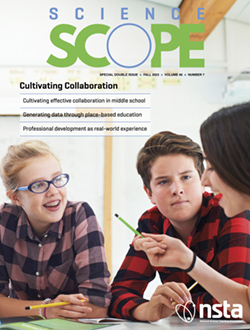Science Scope—Fall 2023

Special Double Issue—Fall 2023
Cultivating Collaboration
Journal Article
Journal Article
Students with visual impairments are often the only students at their school who read braille. They often do not participate in science fairs, in some cases because of low expectations on the part of educators and in other cases because of accessibil...
By Tiffany Wild, Tina Herzberg, and L. Penny Rosenblum
Journal Article
Hearing All Voices to Promote Learning Orientation and Effective Collaboration
Motivation and collaboration intersect in important ways in a science classroom. One important motivational component of collaborative work is what students understand the goal of that work to be (Ames 1992). When students feel they are competing, es...
By Pei Pei Liu, Sharon Taylor, Ann Colwell-Johnson, Alexandra Lee, David McKinney, Christopher J. Harris, Lisa Linnenbrink-Garcia, Gwen C. Marchand, and Jennifer A. Schmidt
Journal Article
Differentiate Science Lessons by Using VR in Station Rotations
Blended learning strategies combined with innovative technology, for example, virtual reality (VR), can be used in science classrooms to differentiate teaching and enrich learning experiences. The positive impacts of differentiated instruction in a c...
By Michael McKenzie and Alex Fegely
Journal Article
Student Uncertainty as a Pedagogical Resource (SUPeR)
As suggested in A Framework for K–12 Science Education (National Research Council 2012), “Scientific knowledge is a particular kind of knowledge with its own sources, justifications, ways of dealing with uncertainties . . . and agreed-on levels o...
By Jamie Rapkiewcz, Jongchan Park, Ying-Chih Chen, and Michelle E. Jordan
Journal Article
How many times have you found yourself sitting in a cafeteria or classroom staring at a professional development PowerPoint being presented by someone who hasn’t been in a classroom or practiced science in years? There is another way! Teachers all ...
By Adriana E. Martinez and Alejandra O. Martinez
Journal Article
Teach Sublimation With Markers!
Sublimation, the change of state from solid to gas, is a challenging concept for many students to grasp and a curious phenomenon to investigate. Our everyday experiences teach us about melting, freezing, and evaporation, but it is rare to witness sub...
By Christine G. Schnittka and Mark Brenneman
Journal Article
Questions are powerful tools teachers can use to understand and scaffold students’ thinking (Clough 2007). However, not all questions are equally effective at eliciting students’ ideas or scaffolding their thinking. For example, open-ended questi...
By Jesse Wilcox, Kean Roberts, Jacob Kaemmer, Jessica McKenzie, and Carson McClain
Journal Article
Using iNaturalist to Support Place-Based Learning and Data Analysis
Often, we think that to learn about nature, students must be in a “natural” place to experience the environment, but this assumption can be problematic on multiple levels. Not all schools have the resources to take hundreds of students on a field...
By Amanda V. Garner and Joshua Rosenberg
Journal Article
Inheritance: It’s More Complicated Than That
For the past 60 years, teaching and learning the science of inheritance and biological variation has largely been centered in Mendelian genetics. In classrooms, genetics instruction generally focuses on traits controlled by a single gene, with genoty...
By Whitney Thwaite, Sara C. Porter, and Hilleary Osheroff
Journal Article
Outdoor Teaching and Learning in Natural Spaces and Outdoor Classrooms
On a humid, sunny day in late July, a group of middle school science teachers closed out three days of teacher professional development (PD) on a nature hike at a forest preserve. Here they engaged as learners, looking for evidence of life cycles to ...
By Samantha Lindgren, Meghan McCleary, Susan Gasper, Amanda Nieves, Kara Stengren, and Amira Shabana
Journal Article
Evolutionary biologist Richard Dawkins said, “There are those who fear reason as cold, bleak, cheerless, unpoetic. That’s not just untrue; it’s the very opposite of true. Science is the poetry of reality” (Dawkins 2016). Science is reminiscen...
By Katie Coppens
Journal Article
Writing these columns often requires a considerable amount of reading and then thinking—both alone and always out loud to my wife as I try to explain to both of us what I have been reading. To be honest, this column reminded me of what I used to jo...
By Bob Riddle
Journal Article
Beavers are social mammals who live in groups, known as colonies, and they construct dams and lodges, which modify the surrounding landscape. In their role as “ecosystem engineers,” beavers are considered to be a “keystone” species. A keyston...
By Jill Nugent


